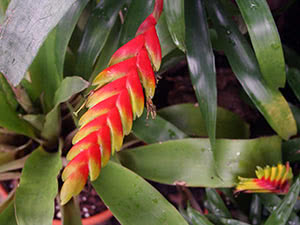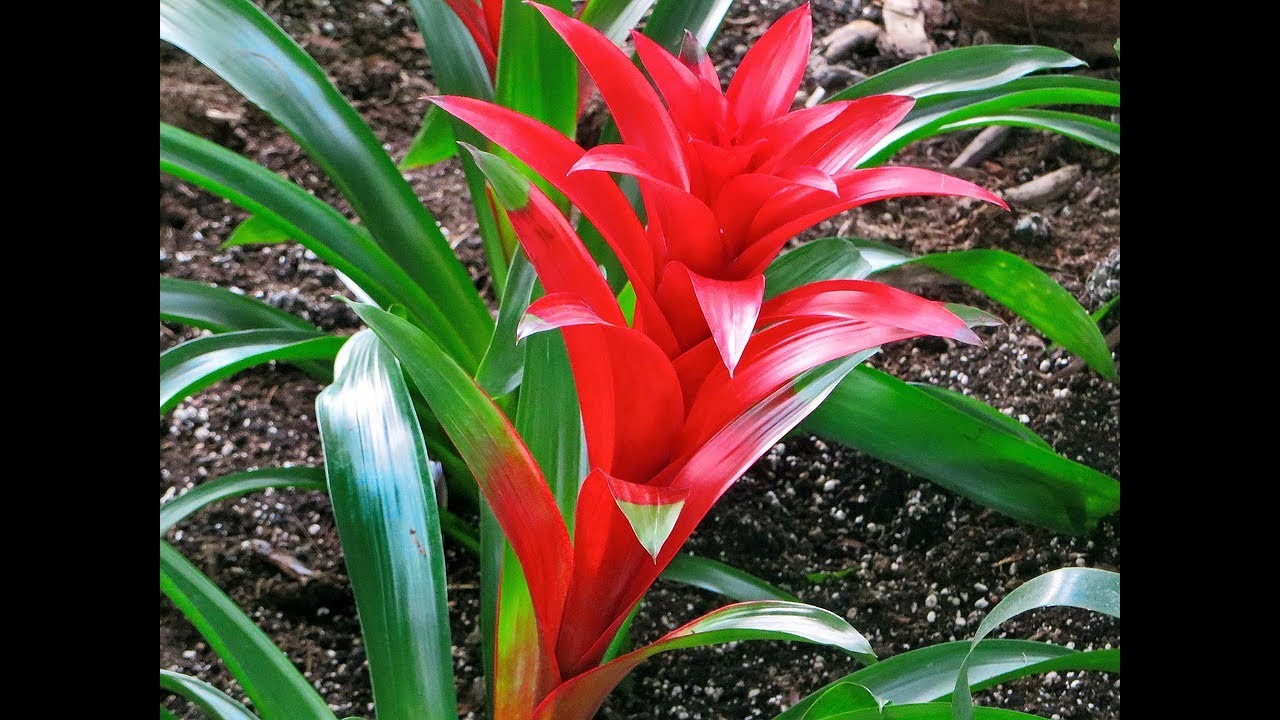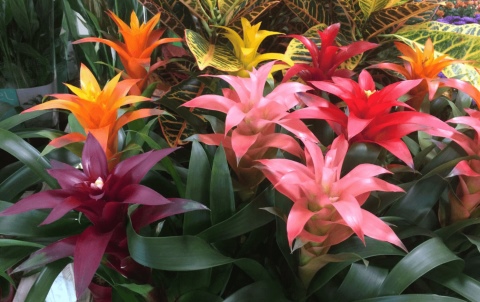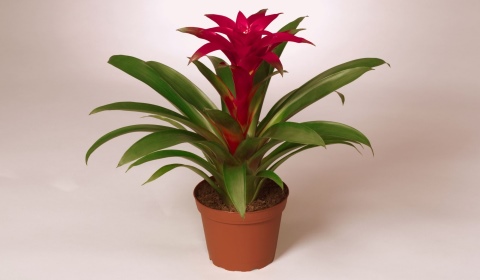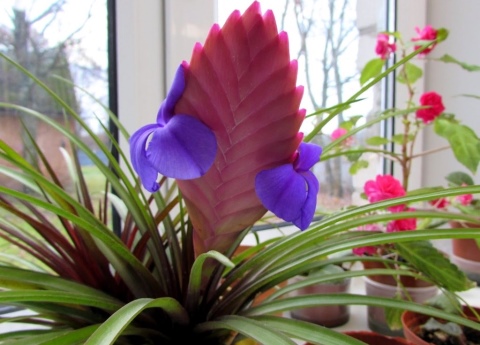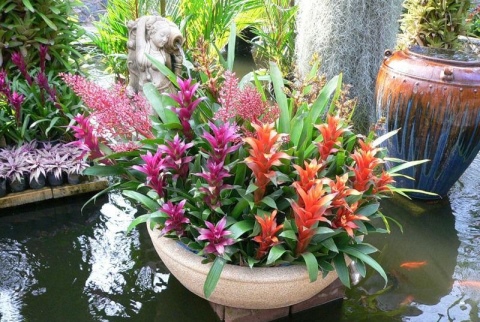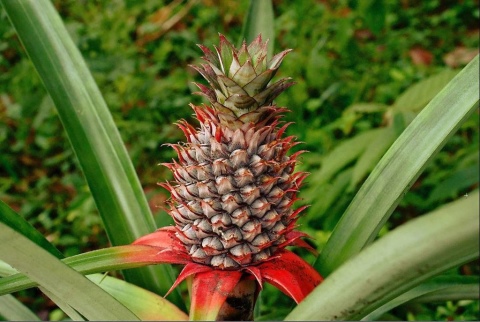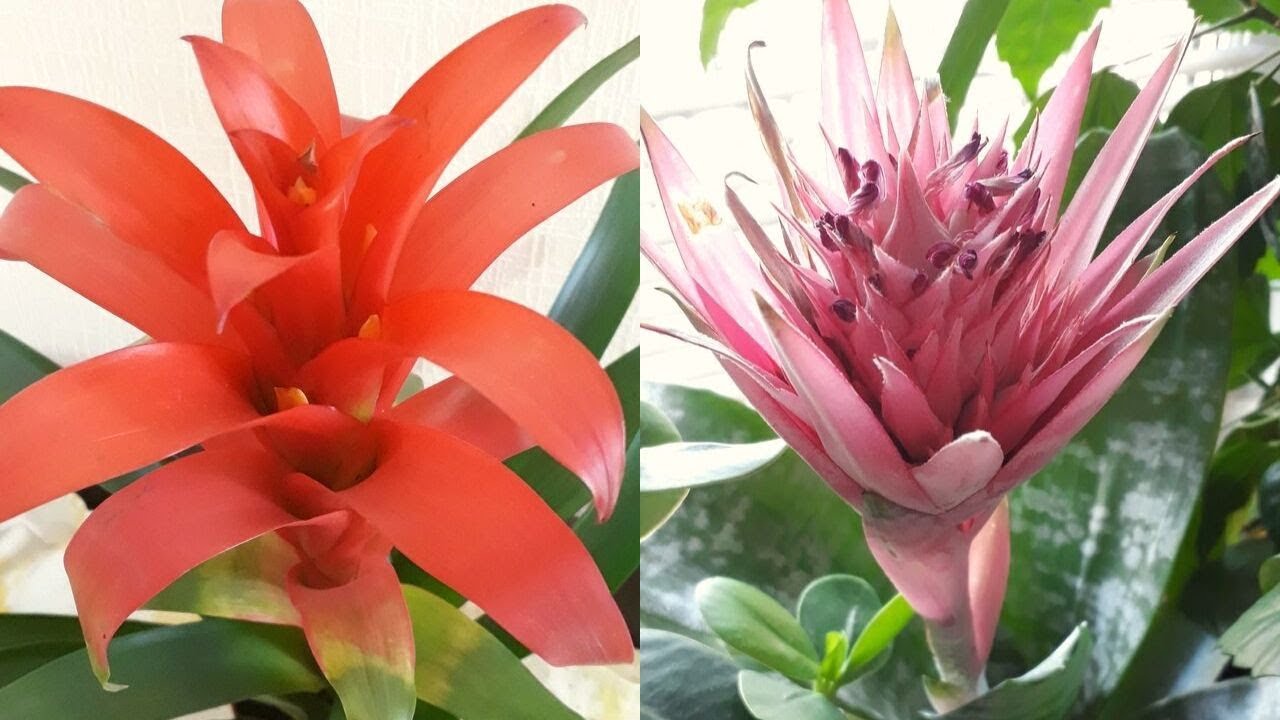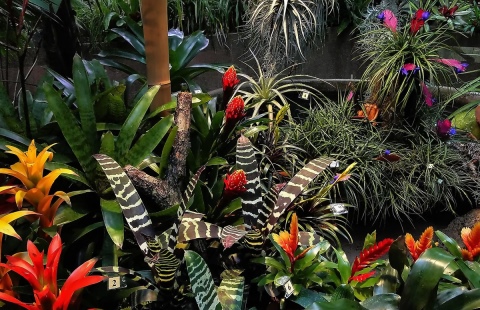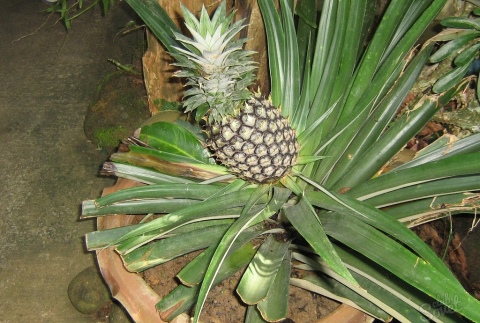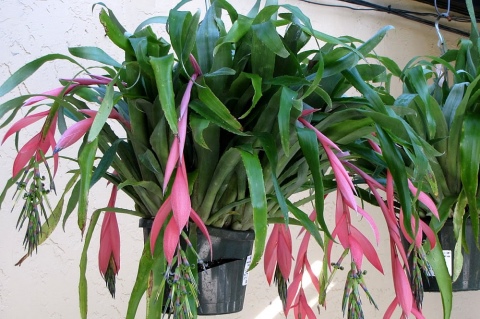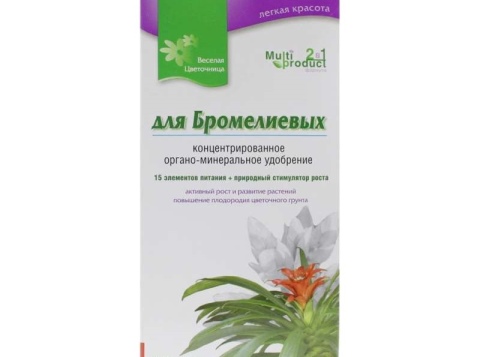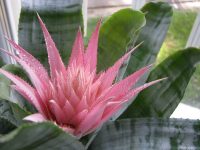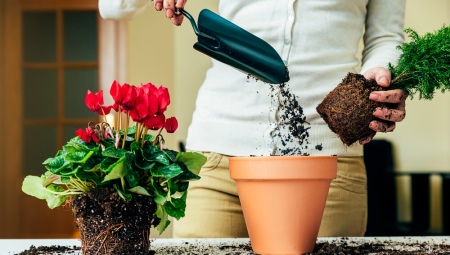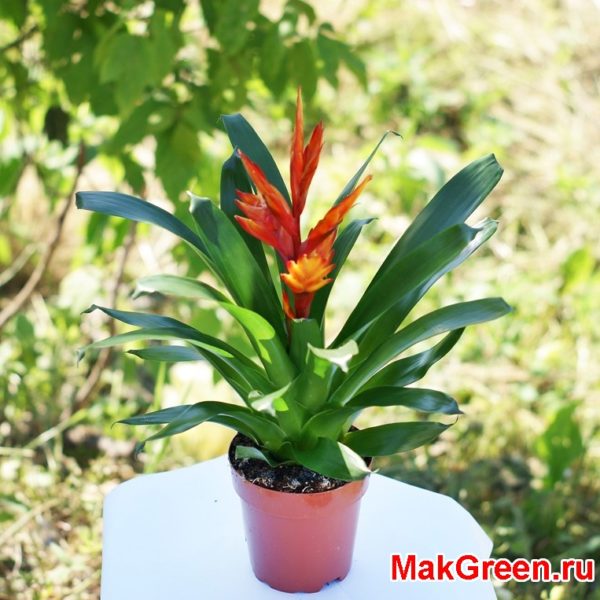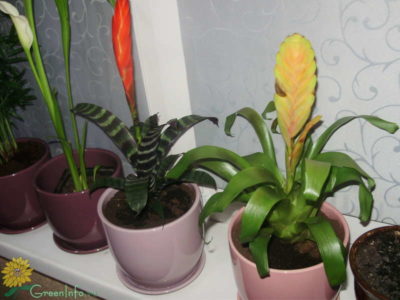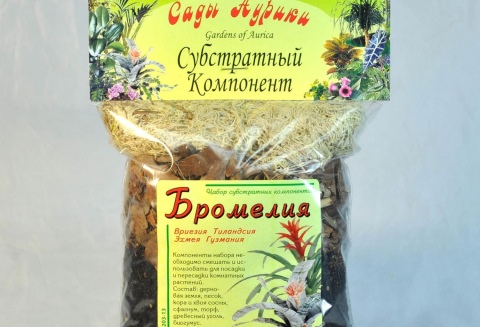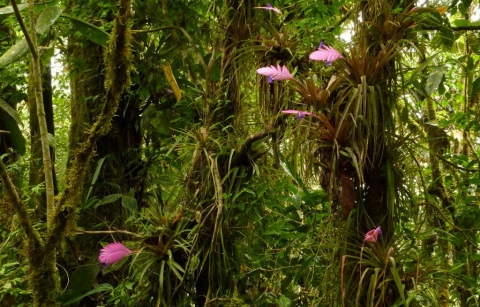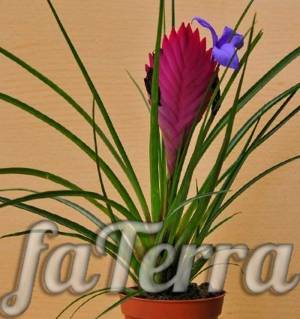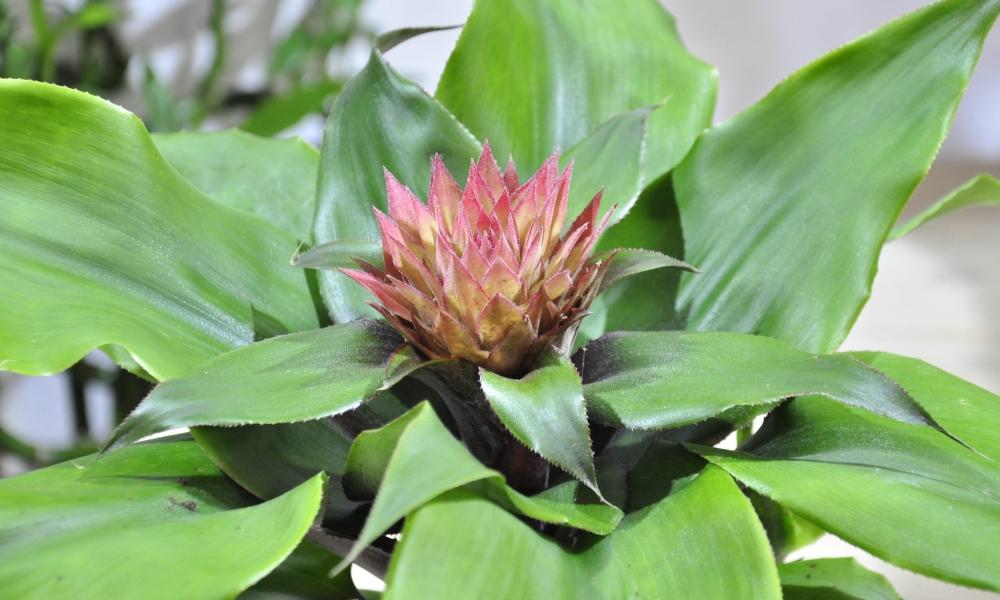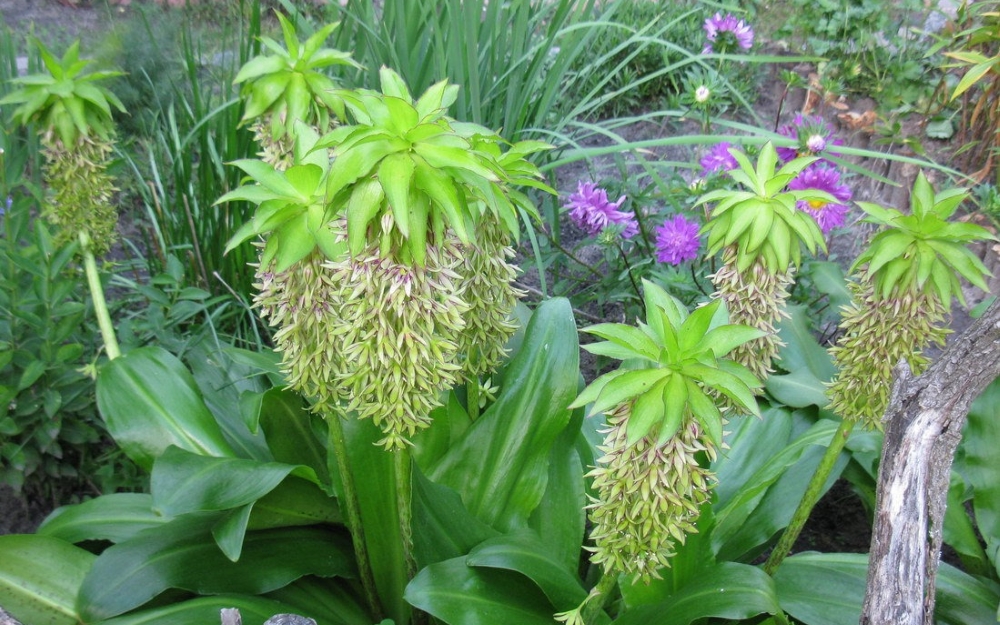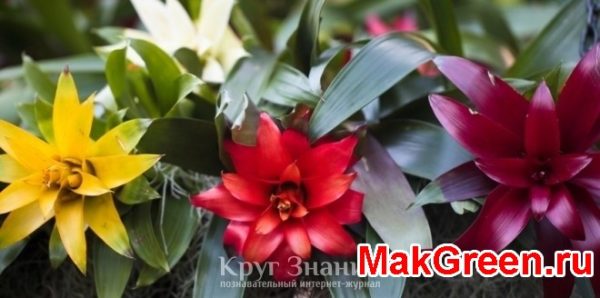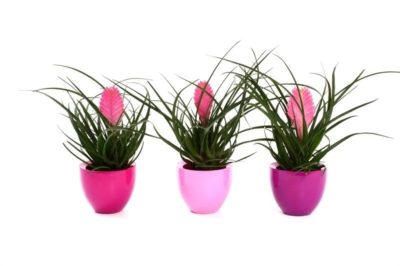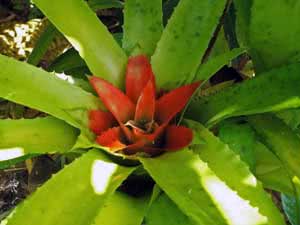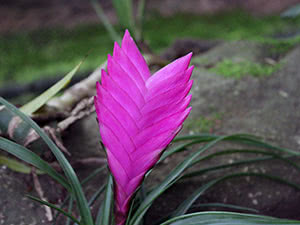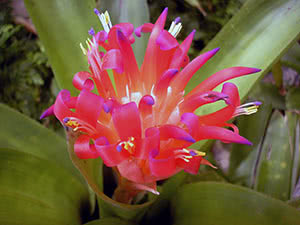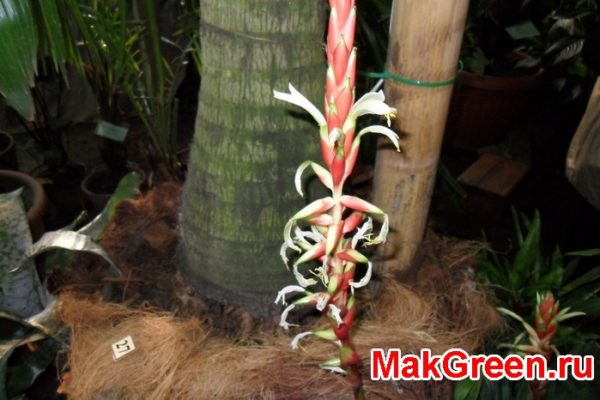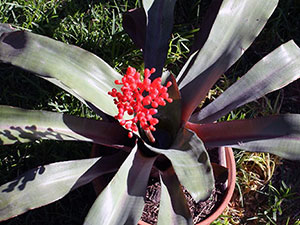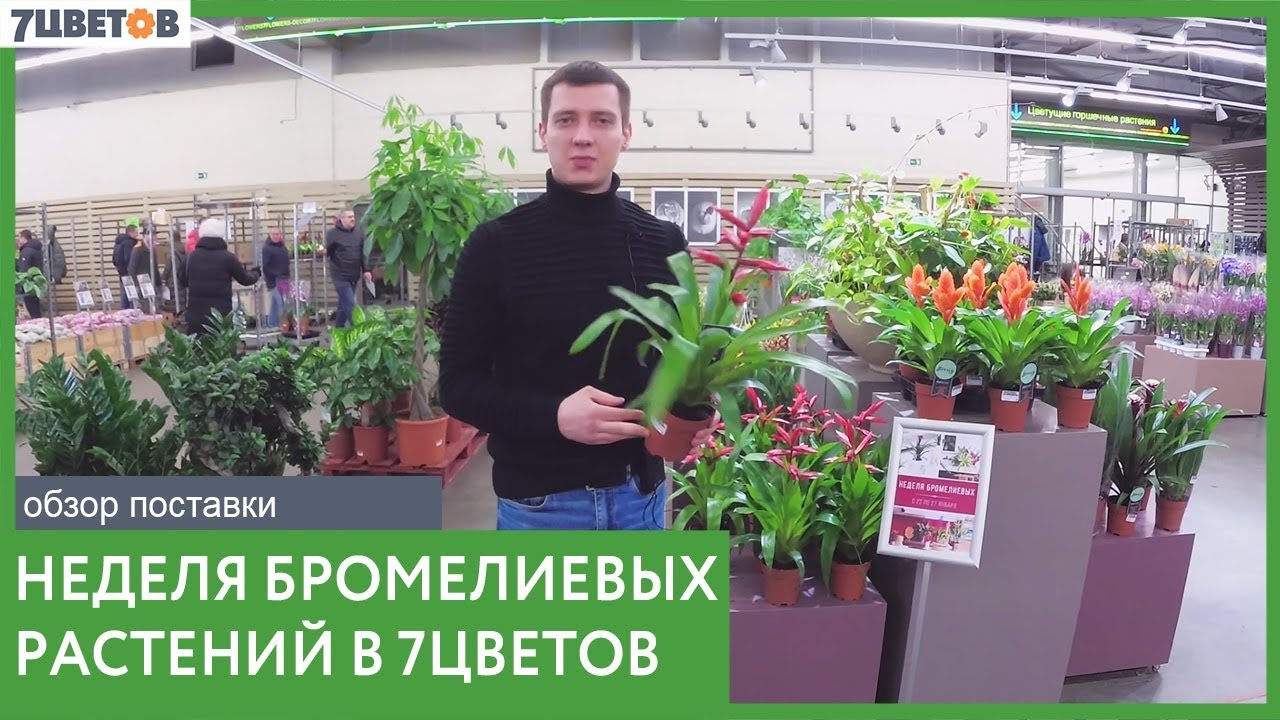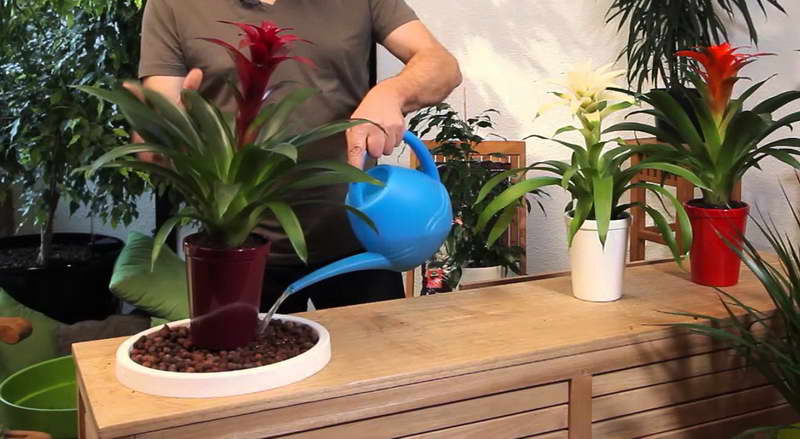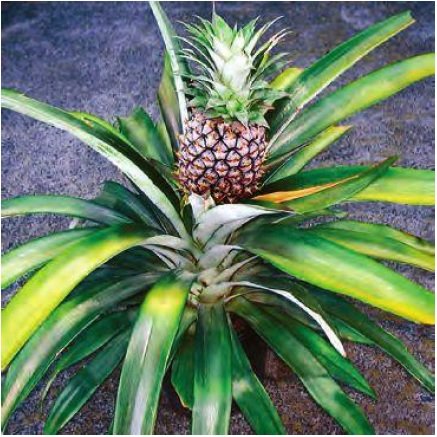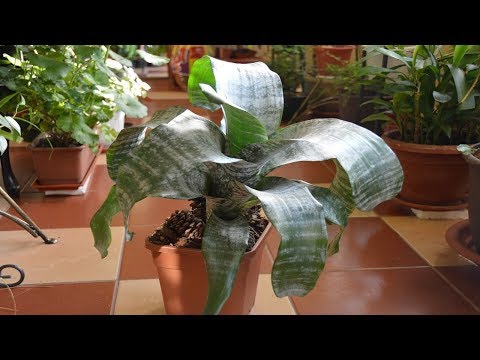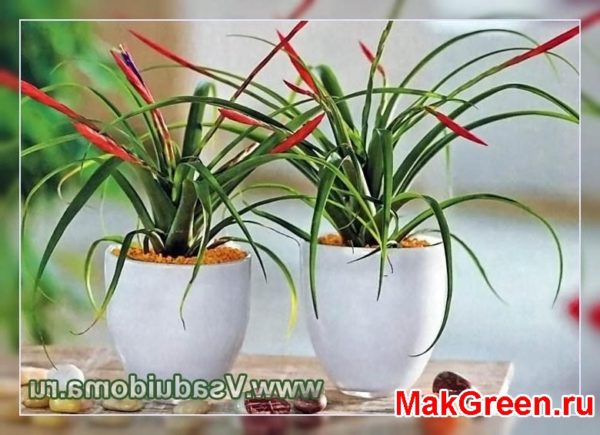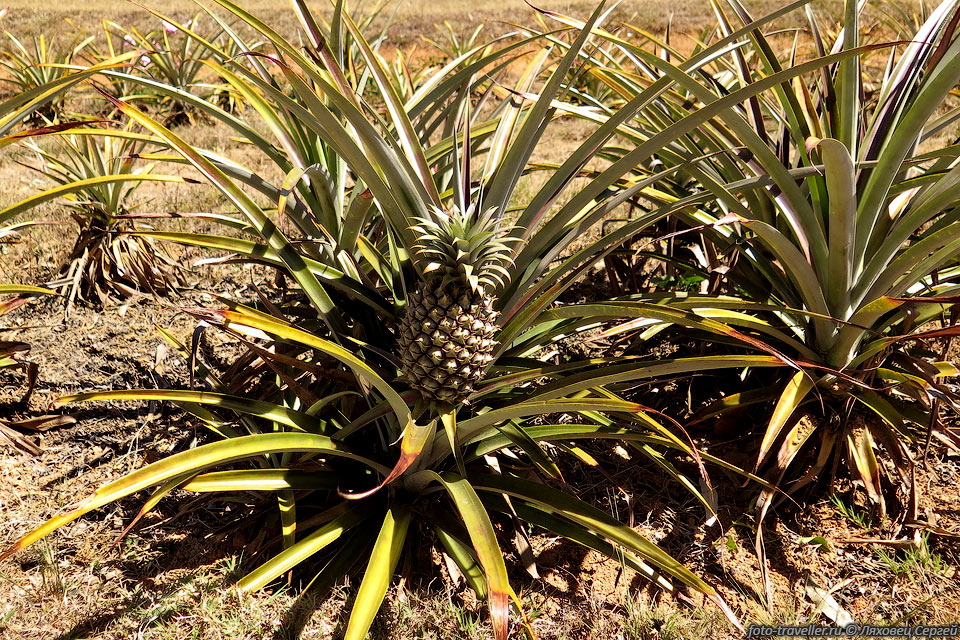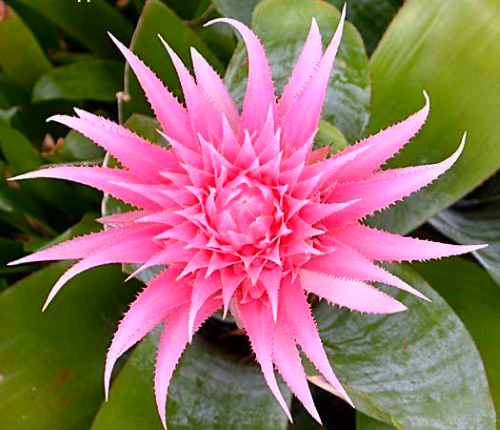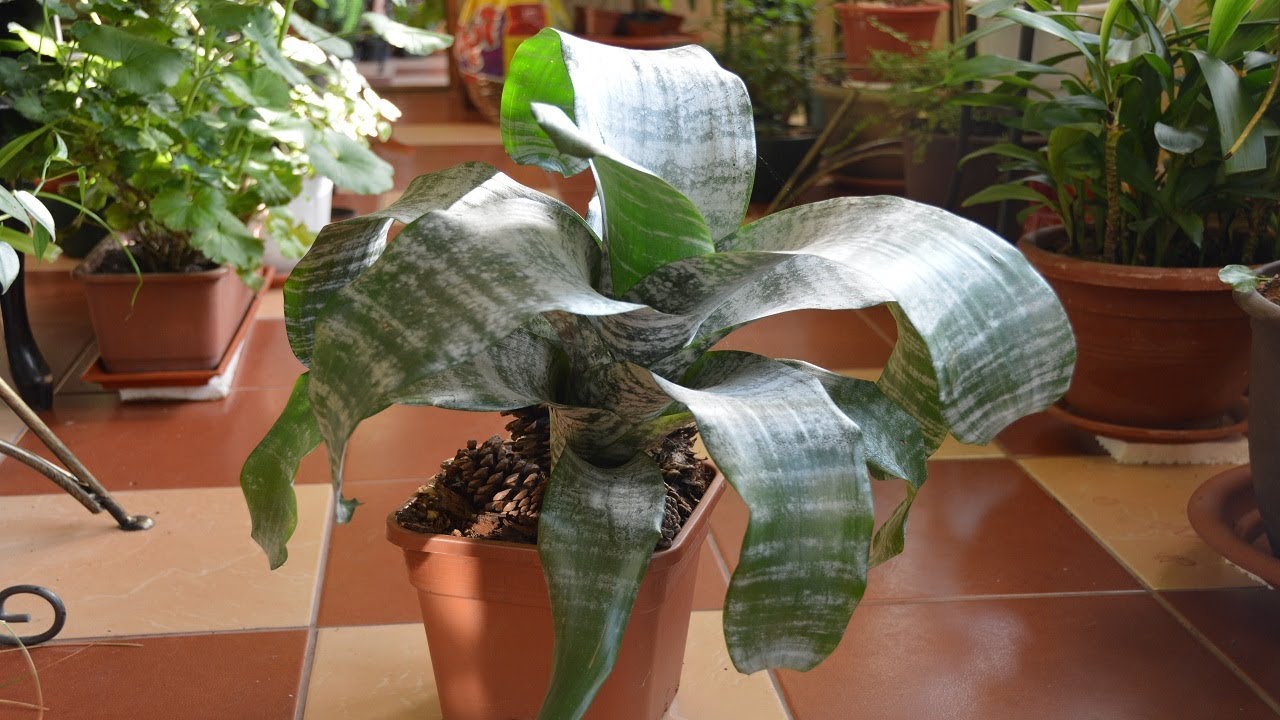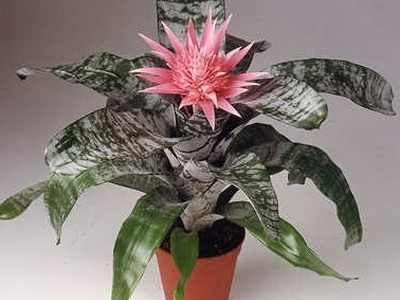Plant care at home
Taking care of a flower is quite simple, but even with all this, it is worth adhering to certain rules and recommendations:
- Indoor humidity level: Bromeliad comes from tropical forests and therefore high humidity is beneficial for it.
- Choose the location of the plant correctly: do not put a flowerpot with bromeliads in a draft and in direct sunlight, and the temperature should be above +12.
- It is worth watering the plant only after the earthen lump is completely dry, while the water is poured into the pan. In the hot season - it must be additionally sprayed with settled water, directing the sprayer into the very outlet of the plant. Periodically, with an interval of 2 weeks, it is worth adding mineral compositions to the water for feeding.
- They are transplanted only after the plant has faded and the children go - after buying from the store, you should not transplant it into a more spacious container. In this case, the soil should be loose and nutritious, the capacity should be 5-7 centimeters larger in diameter than the previous one, good drainage is also a prerequisite for the normal growth and development of the plant.
It is especially important to know how to care for bromeliads so that they release a flower - in order for this exotic plant to bloom, it is worth creating certain conditions for it. First of all, it should be placed on a windowsill with diffused light so that the direct rays of the sun do not fall on the flower.
During this period, spraying continues, but you should not overdo it with watering, since excessive dampness can lead to decay of the roots and the death of Bromeliads. When the plant blooms, it does not require special conditions for its maintenance and care for it continues as before.
Signs and superstitions associated with a indoor flower
Although there are few superstitions associated with bromeliads, they are all positive. It is believed that the flower has the ability to improve people's mood and bring peace of mind to the house. By caring for bromeliads, your daily routine becomes orderly and stable. It is useful to grow a flower for people whose life and work is full of frequent experiences.
 The flower tends to attract positive energy into the house and protect the aura of its owners from ill-wishers.
The flower tends to attract positive energy into the house and protect the aura of its owners from ill-wishers.
Bromeliad also helps to cope with self-doubt and unleash creativity. Therefore, it will be useful to install a flower in a child's room or in the office of a creative person. Taking care of a flower helps to relieve stress, start thinking positively and see the positive side in any situation.
Bromeliad can become a symbol of home and financial well-being. Since the plant needs painstaking care, it can teach the owners to take a responsible approach to their work, to diligently complete tasks and achieve their goals.
Transfer
Wear gloves when handling bromeliads. The plant is not poisonous, but most flower varieties have sharp thorns at the tips of the leaves, which are easy to injure. How to transplant a flower:
At the bottom of the pot, pour a drainage layer consisting of broken brick, expanded clay or pebbles. Please note that these materials should occupy a third of the capacity
Carefully remove the flower, along with the earthen lump, from the old pot. To make it easier to do this, moisten the soil 3-4 hours before the event
Place the bromeliads in a new pot without breaking the earth ball. Fill the voids with prepared soil. Make sure that the root collar is flush with the ground. Tamp the soil and pour warm, settled water over it.
After transplanting, place the flower in a suitable place and provide proper home care for the bromeliads.

Flower varieties
Vriesea

Originally from South America. Large and bright inflorescences outwardly resemble a spikelet or a feather of a bird, and delight the eye for about 6 months. Juicy and dense leaves are collected in a rosette with a diameter of about 30 cm and a height of 40-50 cm. It is necessary to pour water into it from time to time.
Some representatives of this species grow on the ground, others are epiphytes, that is, they use other plants as a support. This plant is very capricious and in order to grow it, it is necessary to observe the temperature regime, humidity level and illumination. Only then will the result be pleasing to the eye! Popular for cultivation:
- Vriezia beautiful - Wide leaves up to 40 cm long, have stripes of dark green or purple. At the top is a spike-shaped inflorescence of yellow flowers and bright red bracts. Grows in the humid forests of Guinea. But you can also grow in our strip.
- Vriezia Sanders - Perennial. It reaches a height of 40 cm. Smooth greenish-gray leaves with a purple tint on the back. The inflorescence is yellow, consists of small tubular flowers.
Ehmea (Aechmea)
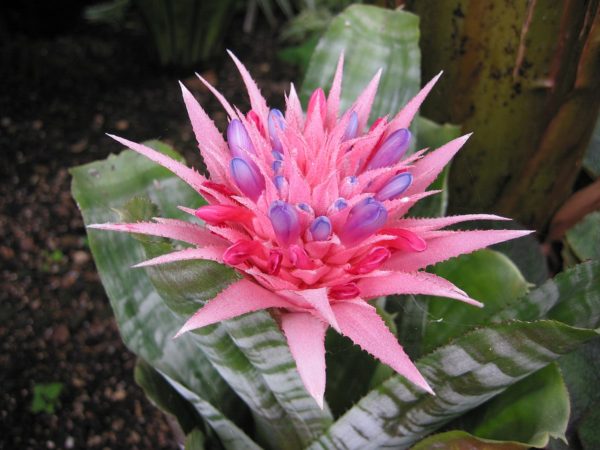
Prefers tropical climate. Lives in hollows, and uses branches for support. The roots are very poorly developed. The stem is thick and short.
The outlet looks like a funnel. The leaf plates are pointed, with a serrated edge. Outwardly, their pattern resembles marble. The inflorescence is erect, pink, has a variety of shapes.
- Ehmeya striped - The scales on the leaves form silvery stripes that disappear in low light. When touched, redness may appear on the skin. the plant is slightly poisonous.
- Ehmeya Chantin- differs in larger sizes, openness, brightness of color.
Tillandsia
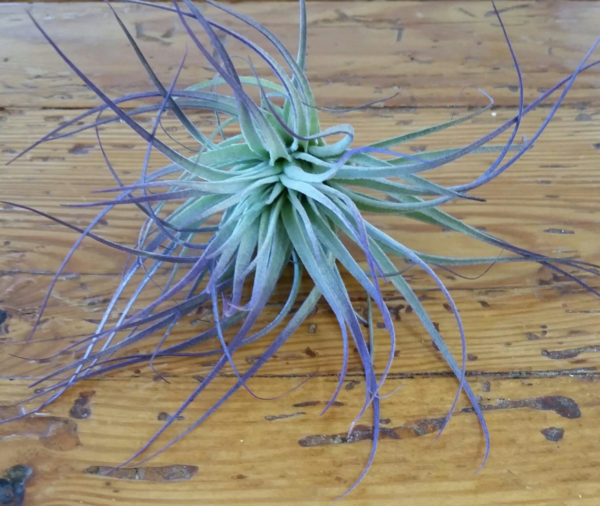
Prefers a subtropical climate. Lives in Mexico and the southern United States. Perennial blooming mainly in summer. The roots are adapted for attachment to objects, so the food is airy. It has narrow dark green lily-shaped leaves, up to 40 cm long.
Small flowers, collected in a spikelet. It is very popular with gardeners and designers, because it has a wide variety of colors and shapes. Sometimes, it is called the "bluebird" for the inflorescence in the blue-violet range.
- Tillandsia "Medusa's Head" - Looks like an onion. Thick, slightly closed leaf plates are closed at the bottom. The inflorescence itself is about 3 cm high. It has a finger-like shape. Very hardy.
- Tillandsia blue - Height 25 cm. Leaves are green above, dark brown below. It begins to bloom in the summer. The flowers have a blue-violet range, but as soon as they bloom, they turn yellow.
Penguin (Bromelia pinguin)
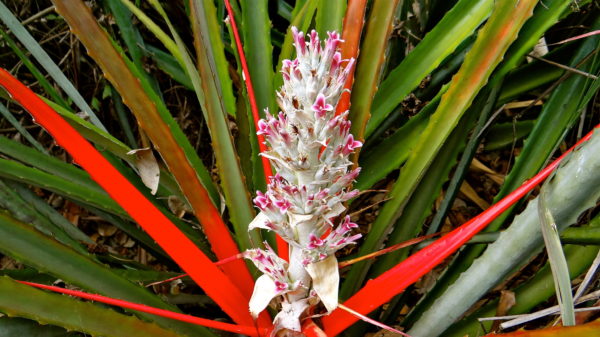
The second name is wild pineapple. And it was not given by chance, because this is the only representative of the family that gives edible, and most importantly tasty fruits. Appearance: shrub almost 2 meters in height with long and thin leaves.
There are thorns that can change their shade from green to yellow or brown. The flowers are small and collected in a cone-shaped structure.
The fruits are in the shape of a bud. The skin is firm but not edible! The pulp is light, soft and juicy. It also contains several pieces of black seeds, which cannot be eaten either.
Guzmania
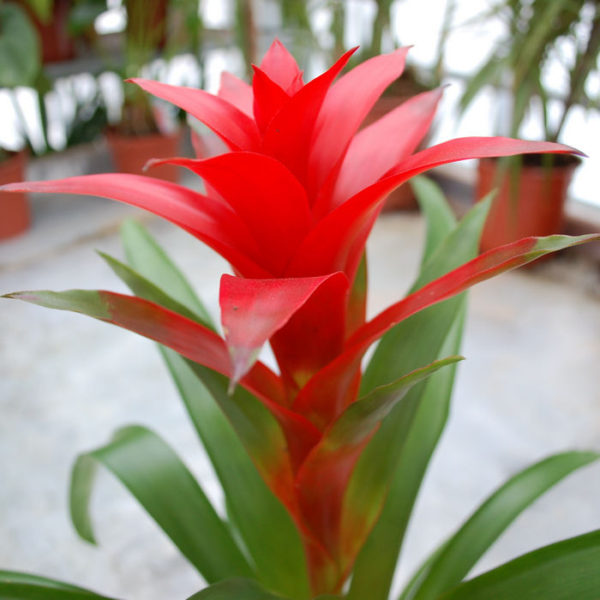
In nature, it is found in Florida, Venezuela, Brazil, West Indies. They prefer flat places at an altitude of 2000m above sea level. Light green leaf plates are collected in a rosette, shaped like a glass. The stem is missing.
The main palette is red, yellow, orange. A distinctive feature is an inflorescence that resembles a fountain in its shape. Flowering begins in March or September and lasts for several months.
- Guzmania reed - it is it that is most often grown in room conditions. The base is a rosette of thin leaves, and in the middle they gather in a corolla.It is he who is often confused with a flower. Real flowers have no decorative value and bloom very quickly.
- Guzmania Tsana. Outwardly, it is very similar to its fellows. Its uniqueness lies in its gigantic size. So, for example, the length of the leaves reaches 1 m.
Neoregelia
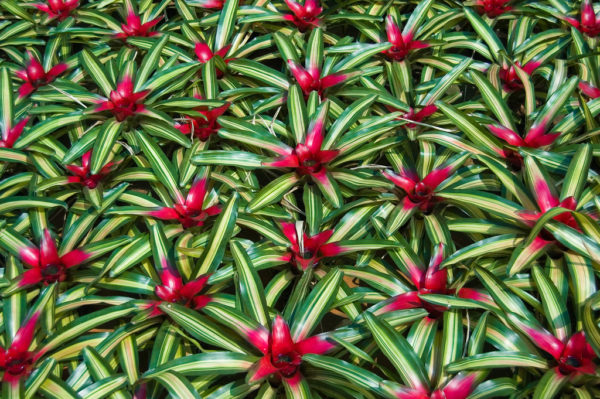
Grows in the tropics of Brazil, Colombia, Peru. Loves wet and swampy places. The leaves are like belts, have jagged edges or sharp thorns. Surprisingly, their tips start to turn red as soon as a raceme-like inflorescence appears.
Neoregelia Carolina is a perennial plant epiphyte. It reaches 0.5 meters in diameter. As soon as the plant begins to bloom, the upper leaves of the rosette turn bright red.
Reproduction at home
The bromeliad slipper flower reproduces by germinating shoots that form around the main individual. The parameter of readiness for separation is the height of the shoot half the growth of the main one.
After the active period, you need to separate a new shoot with a sharp knife, place it in a nutritious substrate consisting of a mixture of peat and sand. The containers are covered with glass or polyethylene. Sprouts need to be kept at a high temperature of 26-28 ° C, as well as a constant source of light and humidity.
Note! After 2-3 weeks, new shoots are transplanted into permanent soil. Bromeliad can also be propagated by seed, but this is a more complicated method.
In the store, they buy ready-made hybrid varieties in a bag, soak them in a solution of potassium permanganate and dry them. Next, the material is placed in a nutrient substrate, creating optimal conditions. After germination, a sprout of several centimeters is expected, which happens in 2-3 months. After six months, the plant is transplanted into a larger pot.
Bromeliad can also propagate by seed, but this is a more complicated method. In the store, they buy ready-made hybrid varieties in a bag, soak them in a solution of potassium permanganate and dry them. Next, the material is placed in a nutrient substrate, creating optimal conditions. After germination, a sprout of several centimeters is expected, which happens in 2-3 months. After six months, the plant is transplanted into a larger pot.
Species names of bromeliads
The Bromeliad family includes about 3,000 species names, but epiphytes are popular in floriculture, shown in the photo - plants whose root systems are mainly needed for fixing on tree trunks:
- ehmeya;
- guzmania;
- cryptantus.
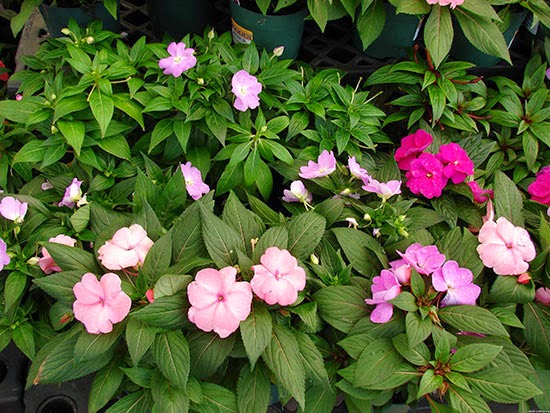 You may be interested in:
You may be interested in:
Growing balsam from the seeds of the house Balsam is a beautiful and unpretentious flower that does not bloom for a long time, but it is very beautiful. The buds are different ... Read more ...
Ehmeya is a perennial known for its decorative leathery leaves and bright large inflorescences. Indoor specimens reach 30-90 cm in length, while in the natural environment, Echmeya sometimes grows up to 2 m.The leaves of the flower are long - up to 50 cm, have a linear or belt-like shape, and a chaotic pattern. The edge of the leaf blade can be pointed or rounded. At its base, echmeia leaves fold into a rosette with a funnel in the center.
During flowering, a large spike-shaped or capitate inflorescence appears on the plant, which has a dense peduncle. One inflorescence can contain many shades of pink, lilac and blue flowers. Ehmeya is a poisonous plant, its juice can irritate the skin, so you need to take care of an exotic plant with gloves.
Guzmania is a tropical plant characterized by oblong glossy leaves collected in a rosette, from which an inflorescence in the form of an ear appears. The inflorescence is formed from bright leaves-bracts, between which there are white and yellow small flowers. Flowering lasts 4 months, after which the plant dries up.
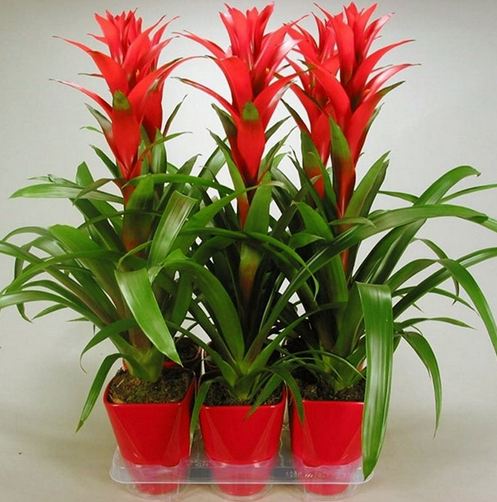 Guzmania
Guzmania
There are several different types of guzmania, each with a unique flowering:
- blood-red guzmania - corymbose inflorescence, consists of 7-12 flowers, when flowering, the leaves become rich red;
- guzmania mosaic - the rosette of the flower looks attractive even before flowering. The species is characterized by long leaves with green and reddish-brown stripes;
- guzmania ligulate - the inflorescence is formed by bracts of pink or bright red color.
Criptanthus is an "earth star", a perennial, a distinctive feature of which is the absence of stems. The flowers of the plant are located in deep dense foliage, so it can be difficult to see them. The stripes of long leaves can have a different shade: green, yellow, red, white.
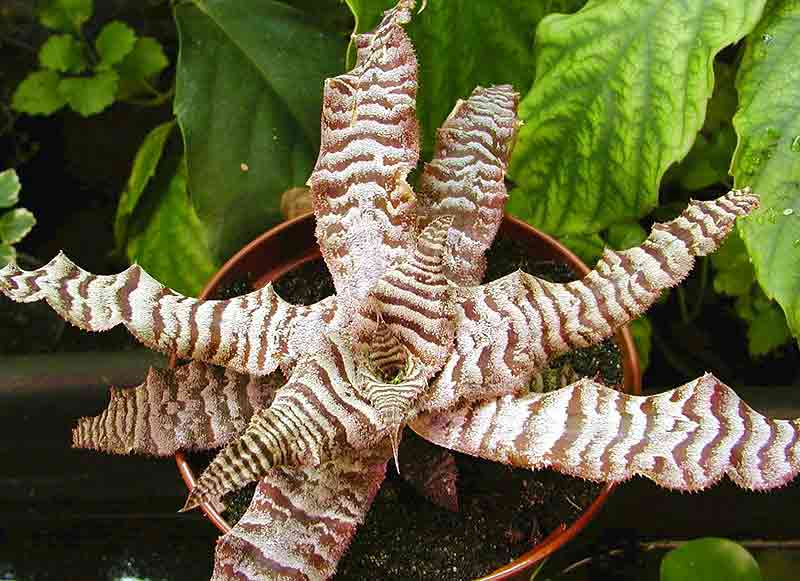 Cryptantus
Cryptantus
The edges of the leaves are wavy, serrated, and compensate for the not too attractive white inflorescences. Criptanthus is the smallest and most whimsical representative of bromeliads.
Home care
A feature of keeping and caring for bromelia at home is maintaining a special regime of humidity and temperature. Under natural conditions, epiphytes receive the necessary moisture from the air and from the soil, therefore, the wettest place with good lighting should be taken at home bromeliads. The flower is recommended to be placed on the eastern or southern windowsills, where it will feel comfortable. Bromeliad does not tolerate drafts and cold air. The most favorable temperature for keeping a flower is above 25 degrees.
Watering plants and moisture
Proper watering is of particular importance when caring for bromeliads at home. You should be aware that the roots of the plant cannot completely absorb all the moisture, so the plant should be watered into a leaf outlet. In summer, watering is carried out once every two days, in winter it is reduced to once every 7-10 days.
It should be controlled that the soil is always moist and the roots do not dry out. To keep the humidity high, you can use a humidifier or place the pot in a tray of damp moss.
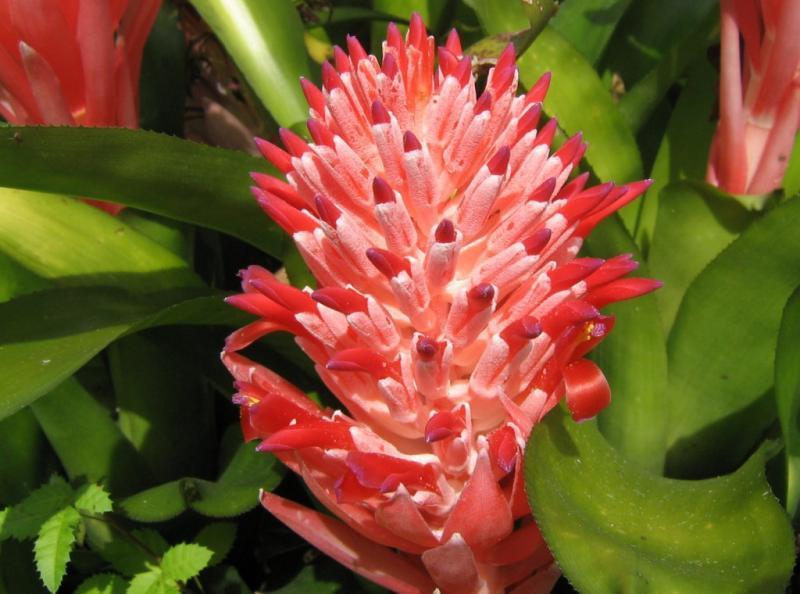
Spray the leaves as often as possible and wash the outlet from dust and dirt once every few months. Do not pour water into the outlet while spraying. This can cause leaf rot and flower death.
Boiled warm water should be used for watering.
Soil and fertilizing
 Soil for bromeliads should be good for moisture and air. For the preparation of the soil mixture, leafy soil, peat, humus, sand, crushed coniferous bark and charcoal should be used in equal parts. You can also use ready-made orchid potting mix.
Soil for bromeliads should be good for moisture and air. For the preparation of the soil mixture, leafy soil, peat, humus, sand, crushed coniferous bark and charcoal should be used in equal parts. You can also use ready-made orchid potting mix.
Growing and caring for feijoa at home
The drainage layer should fill one third of the container. Expanded clay or brick chips can be used as drainage.
Top dressing is carried out during the period of active growth. If the growth of the rosette has slowed down or stopped, it is recommended to use a complex mineral fertilizer. The flower requires a minimum amount of feeding, since in natural conditions bromeliad costs an insignificant supply of nutrients. As a rule, fertilization is combined with watering by pouring a small amount of the solution into the outlet.
Transplant and reproduction
Bromeliads do not tolerate transplanting well, so it is better to grow new plants from daughter plants.
Shoots that have formed near the base are well suited for transplantation. You can transplant bromeliads as follows:
- Fill a small container with nutrient soil;
- to separate the shoot when its height is one third from the mother plant;
- deepen the sprout into the soil by 3 centimeters;
- during the formation of the root system, support the young plants with a peg.
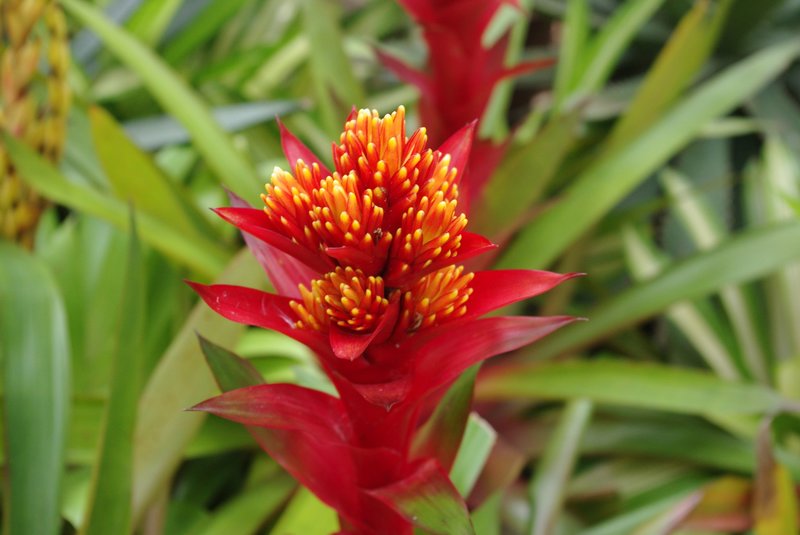
Home care
When growing indoors, it is necessary to adhere to certain maintenance rules.
Lighting
Blehnum prefers to grow in diffused light or partial shade.Therefore, the pot with the plant is placed on the northern windowsills or away from windows.
Temperature regime
In the winter season, the plant is kept at 18–20 degrees. Temperatures below 16 degrees are unacceptable, blechnum may die.
The fern does not tolerate drafts and temperature changes, so the room is ventilated carefully, not allowing cold air to enter it.
Watering
In the summer, the plant is watered abundantly, and moderately during the dormant period. The soil in the pot must always be moist, it must not be allowed to dry completely. For irrigation, use warm, settled water.
At the same time, blechnum grows comfortably in high humidity. Therefore, it is regularly sprayed with a spray bottle. Or, containers with water and humidifiers are installed next to the pot.
Some growers keep fern in a spacious, well-lit bathroom.
Land mixture and plant fertilization
The plant actively develops in loose, neutral or slightly acidic soil. An excellent fern substrate, which is purchased at a flower shop. Or they prepare it yourself. To do this, combine together leafy earth, humus, peat and sand in a ratio of 2: 1: 1: 1. Additionally, crushed bark of coniferous trees is added.
Top dressing is carried out from March to September. Use a mixture for ferns or fertilizer for ornamental foliage plants. Carried out 1 time in 14 days. Dilute less than indicated in the instructions 2 times.
Between October and February, Blehnum is not fed.
Planting and transplanting
A transplant is carried out in the event that the roots of the blehnum have filled the entire pot and began to look out of the drainage holes. The procedure is carried out in the spring season. The new container is selected more than the previous one by 4-5 cm.
The process is carried out very carefully, trying to touch the roots as little as possible. The fern is transferred into a new container, slightly cleaning the top layer of soil. Empty spaces are filled with substrate. A drainage layer must be placed on the bottom of the pot. Then watered and looked after, as for a normal plant.
Reproduction
To obtain a new plant, the fern is propagated at home. The process is carried out in two ways:
- Disputes. They are formed on the lower surface of the leaves. Sown in the spring. The sheet is cut off and the spores are scraped off onto paper. A drainage layer is poured into the container, and on top of the soil, which is watered abundantly. Then the disputes are dispelled. Cover with glass and put in a warm, dark place. Ventilate and moisturize regularly. Sprouts appear after 3–6 weeks. The container is transferred to a lighted area, and the greenhouse is removed. After the plants grow up, they are transplanted into separate pots.
- By division. Well-grown specimens with roots and at least 4 points of growth are separated from the mother plant with a knife. Places of cuts are processed with crushed coal. Slightly acidic soil is poured into the container and plots are planted there. Then watered abundantly. They develop very slowly, a noticeable growth can be seen a month after planting.
Blehnum does not recommend dividing bushes on hot summer days, as the plant can experience severe stress.
Diseases and pests
The fern is often attacked by pests; it is most vulnerable to spider mites, aphids, and scale insects. Insecticidal preparations are used to combat. But with a weak infection, the leaves are wiped with a sponge dipped in soapy water.
With improper care, the following growing problems can arise:
- Drying of the tips of the leaves. It happens from dry air in the room and being near heating appliances. Blehnum is often sprayed, and containers with water are installed nearby.
- Leaves turn yellow and brown spots appear. The plant is in the heat for a long time. The pot is rearranged in a shaded place.
- Leaves are faded and lethargic. There is too much sunlight in the room.Windows must be shaded at noon.
- Leaves wither and fall. Blehnum is watered with cold water or the room is too cold. The flowerpot is rearranged to a warmer place, and for irrigation they use settled water at room temperature.
Often, flower growers are faced with the fact that blehnum grows poorly, this happens due to improper soil or too tight a pot. The plants are transplanted into another container with a suitable substrate.
Growing epiphytic bromeliads
All these plants are characterized by gradual dying off after flowering, which can last for several years. They are used mainly as a long-lived bouquet and after flowering and loss of bright color of the leaves, they are usually thrown away. Although, if the necessary conditions are created, the mother plant will be able to give daughter rosettes, and in a few years they will be able to bloom.
When buying a plant, pay attention to the condition of the leaves, the tips should not be brown and dry. Often the tips of the leaves or their bases, the underside may not be painted in green, but in shades of red or purple - this is the norm, such plants can be bought
Be sure to inspect the plant, mealybug is a frequent parasite. If you find it, refrain from buying. Bromeliads are bought mainly in the cold season, so be sure to take care of warm transportation home, the plant should not be exposed to cold air for a second.
Transfer. Plants do not need to be transplanted after purchase, the root system is not very developed, there is enough space and the soil is selected of the desired quality. A transplant will be required after the appearance of daughter plants, which can be planted one at a time, or you can remove the dead mother plant from the center and transfer everything together into a wide bowl - you will immediately get a composition.
Priming. These plants require very light and loose soil. There are special substrates for bromeliads on the market, but you can prepare them by mixing in equal proportions orchid substrate and universal high-peat soil.
The lighting is bright, diffused, a small hit of oblique sunlight is permissible. In winter, fluorescent lighting is required to create a 12-hour daylight hours.
Temperature. It is advisable to maintain a warm room temperature all year round, always with additional lighting in winter. If there is not enough light in the winter, then it is necessary to lower the temperature of the content to + 15 + 17 ° C so that the plant does not deplete.
The air humidity should be high, spray the plant often, put it in a composition or on a tray with damp pebbles. At temperatures below + 18 ° C, cancel spraying to avoid rotting of the plant.
Watering is very important for these plants. You can often find information that it is necessary to water into the sockets. Many bromeliads are indeed adapted to collect atmospheric moisture with their leafy rosettes. But in nature, water is of a completely different quality and in these reservoirs, as in aquariums, many microorganisms live, which are in a certain biological balance. At home, there is no such balance, so usually watering into an outlet ends with rotting of the plant. It should be watered exclusively in the ground, regularly and in moderation, not leading to waterlogging. The topsoil should dry out a little between waterings. Spray frequently, but do not let the water stagnate in the outlet.
Top dressing. Bromeliads do not require high doses of fertilizers; orchid fertilizers can be used for them. As leading an epiphytic lifestyle, they are adapted to receive nutrients through the leaves. Therefore, some of the fertilizers can be applied foliarly, by spraying the leaves with a weak solution of fertilizers.
Bloom.What is usually mistaken for a flower in bromeliads is the inflorescence or modified upper leaves. The flowers themselves are small and often inconspicuous, they quickly fade. The inflorescence can retain its decorative effect for many months. After the end of flowering, the mother plant gradually dies off, giving children. With proper care, young plants can bloom in 1.5-2 years.
Reproduction at home occurs due to the growth of daughter plants in the axils of the lower leaves of the original specimen, which begins during flowering or immediately after it. There is no need to rush to separate the children, at the first stages of growth they feed on the mother plant, you should definitely wait for the daughter plants to grow their own roots. Usually this moment comes when the baby is almost the size of the mother plant. It is best to wait for the complete death of the original plant and even then either separate the children one at a time, or leave everything together by removing the parent plant.
Pineapples can be renewed with the green top of the stem. It is carefully cut, freed from the remnants of pulp and lower leaves, behind which sometimes the rudiments of future roots are already hiding. The crown is slightly dried, the lower part is sprinkled with charcoal and planted in loose sandy soil, supported by moderate watering.
Bromeliad family
The Bromeliad family includes three subfamilies. It:
- Pitcorniaceae (Pitcairnioideae);
- tillandsia (Tillandsioideae);
- bromeliads (Bromelioideae), or pineapple.

What does a bromeliad flower look like?
For your information! There are about 3 thousand species and varieties of this cereal-flowering perennial herb.
Houseplants from the Bromeliad family: types and features
According to the description, bromeliads have a close relationship with the familiar pineapple, which is quite an edible fruit. And this is no accident, since they are relatives.
All types of culture are of floristic interest. But of them cryptanthus, guzmania, vriezia, indoor pineapple, ehmeya, neoregelia, bilbergia, acanthostachis, neoregelia, nidularium are most in demand.
Common features of all varieties and types:
- seasonal flowering, that is, in summer;
- the inflorescence is a modified, apical leaf rosette;
- the ability to bloom only once. The peduncle dies, leaving behind a bunch of children.
For breeding, babies (kiki) and seeds are used. The first method is used more often.
Note! Flowering can be accelerated by stimulating the flower with ethylene. It is produced by fruits such as an apple.
General information about the Bromeliad family
In the Bromeliad family there are plants and epiphytes growing on the ground. The latter grow by clinging to nearby objects (trees, bushes, stones, buildings, etc.). However, they are not parasites. Food is obtained from air (moisture droplets) and sunlight.
The leaves of the culture are dense, glossy. As they develop, they form a funnel-shaped rosette. The top of the flower changes over time (due to the bracts). An inflorescence (racemose, capitate, paniculate or spike-like) grows from it. The color of the brushes is very bright - all shades of red and yellow.
The flowering period depends on the species and can last from 2-3 weeks to 2-3 months.
What to do after purchase
An attractive home plant, bromeliad, is sold in flower shops in two flavors:
- young crops that do not yet have buds;
- already blooming, luxurious specimens.
If you are buying a bromeliad that has not yet blossomed, then carefully examine the plant. It should not show signs of mechanical damage and rot. After purchasing a healthy specimen, immediately transplant it into a new pot. So the plant will quickly acclimatize in your conditions.
Adults already flowering bromeliads are not recommended to be replanted. They do not tolerate the event well and may die after the procedure.But before you add a new pet to other house plants, keep it separately in quarantine to make sure that the bromeliad is healthy and does not tolerate disease.

